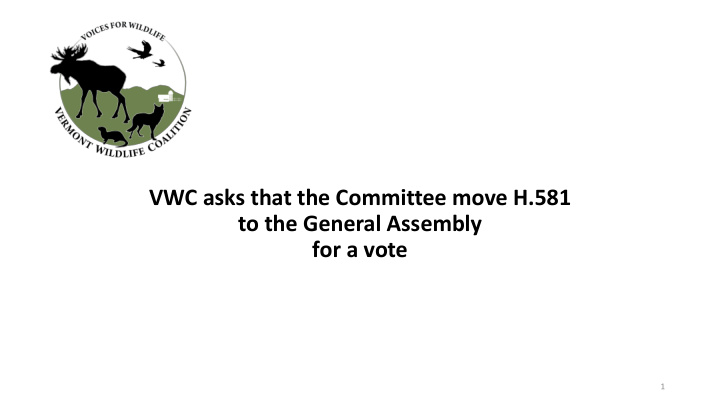



VWC asks that the Committee move H.581 to the General Assembly for a vote 1
There are two primary drivers of this bill 1. DFW Funding Crisis 2. Wildlife Species Face Significant, Long Term Threats 2
There Is an Industry-wide Funding Crisis “The amount of funds currently available for wildlife conservation is only capable of meeting a small fraction of the need.” National Wildlife Federation (2018) 3
There Is a Vermont Funding Crisis “To remain financially stable long term, the department will need to address its funding crisis.” DFW Performance Based Budget Report - 2017 “Further drops in licenses would pose a serious financial, administrative and bureaucratic threat.” DFW spokesperson in Vermont Digger - December 29, 2019 4
There Is Also a Wildlife Crisis “Yet what is hidden from most Americans is another impending fish and wildlife crisis. For every game species that is thriving, hundreds of nongame species are in decline.... In the coming years, thousands of species could be added to the list of federal threatened and endangered species.” Association of Fish and Wildlife Agencies (VT DFW is a member) 5
“As many as one-third of America’s wildlife species are at increased risk of extinction.” Joint report by National Wildlife Federation, American Fisheries Society and Wildlife Society (2016) 6
The Crisis Has 976 Arrived in Vermont “A significant # of SGCN species listed in number of wildlife Vermont's 2015 species need help.” Wildlife Action Plan SGCN: Species of Greatest Conservation Need VT's Wildlife Action Plan 2015 7
Why Is There a Wildlife Crisis? According to Vermont's Wildlife “Given the magnitude of climate Action Plan, the causes are: impacts, rates of increasing variability, and the synergy between climate and non-climate • Climate Change stressors on wildlife and the • Habitat Loss and Fragmentation habitats upon which they depend, • Impacts of Roads and there is an urgent need to Transportation Systems prepare for and respond to these • Pollution impacts.” • Invasive Species • Disease Vermont's Wildlife Action Plan 8
- The future of our wildlife is in peril - funding and the capacity to address the emerging threat to wild species are inexorably and directly connected Funding Crisis Wildlife Crisis 9
Current Solutions Are Not Working Federal Grants Decreasing License Fees Decreasing 26% 33% • Requires match from fees • Politically Unstable • Since 2005 • Demographic trends • Social/cultural changes 25% General Fund Increasing • Filling the gap 2021 governor's budget • Politically Unstable 10
Budget Trends: 1990 to 2021 70% 64% 60% 50% 40% 37% 34% 33% 30% 27% 26% 25% 20% 14% 10% 9% 0% 1990 2006 2021 Licenses Gen. Fund Federal 2021 data from governor's projected budget 11
A Key Weakness of Historical Funding • 21,000 wildlife species in VT in total (VT WAP) • About .003% are game/sportfish species (about 70) • Game species are, with exceptions, not currently threatened • Non-game species = more than 99% of SGCN • Non-game species are in crisis in VT and across the U.S. Historically, funding has been oriented to game species SGCN: Species of Greatest Conservation Need 12
Why a Legislative Working Group? Only legislators can: 1. Step outside of the historical funding mindset and proactively address the crisis 2. Access the expertise and records required to create better funding options 13
Funding Must Increase • Monitoring and research to protect species will be expensive • Habitat protection will be expensive • Only in the early stages of understanding the impact of invasives and pollution • More species will be threatened over time • The full picture of threats is not yet known • Public demand for DFW services will only increase over time 14
Funding Must Be Stable • DFW should not be constantly distracted by funding insecurity • Dependable funding supports the DFW's capacity for creating effective solutions • Stable funding also supports Vermonters' quality of life, economy and identity 15
Funding Must Be Diversified “Diversified funding” means: 1. A variety of funding sources (licenses, state, federal and more) 2. Contributions from the broad public Wildlife watchers, for example, spend $3 on their avocation for every $1 hunters spend 3. The Vermont public is willing to contribute 16
Funding Must Target Contemporary Needs To establish those needs, the Working Group would: 1. Examine current allocations of department resources 2. Evaluate if those allocations make sense in light of current priorities and challenges 3. Recommend funding levels going forward for 15 years 4. Recommend new sources of funding 17
Vermont Wildlife Coalition P.O. Box 987 Shelburne, VT 05482 info@vtwildlifecoalition.org vtwildlifecoalition.org 18
Recommend
More recommend